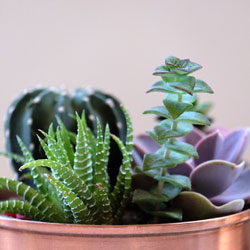Succulents are charming plants and can be a great addition to your household jungle. Learning more about these popular plants can help you give them the best growing environment so they are sure to thrive and show off their unique foliage, amazing colors and fascinating structures.
What Are Succulents?
If you are familiar with aloe, agave, jade or snake plants, you already know some of the most popular succulents. But what makes these plants different from other houseplants? Succulents store moisture in their thick, fleshy leaves and can go long periods without regular watering, making them ideal for anyone with a busy schedule. These plants are also great choices for growing in arid or drought-prone areas, xeriscaping zones and rock gardens, and they are especially quaint in all sorts of containers. They are slow growers and very forgiving of occasional neglect, which makes them perfect for anyone whose green thumb might not be quite so green when it comes to houseplants. Yet with a tremendous variety of succulents available, even the most experienced houseplant gardener can find a new succulent to enjoy and appreciate.
Choosing Succulents
There are many beautiful succulents available, with sizes ranging from tiny, delicate plants perfect for a miniature scene or fairy garden to much larger, stately plants that make excellent statement pieces. When choosing succulents, look for a variety of colors, textures and shapes to experiment with, and consider mixing and matching smaller plants for more visual interest in one arrangement. Take care, however, that the plants you choose for the same arrangement have similar care requirements and needs so they can grow comfortably together. If you’re choosing larger plants, a single succulent can be amazing on its own as it reaches its full potential.
Caring for Succulents
Succulents are relatively easy-care plants, but they do have specific needs. By meeting those needs, you are sure to give all your succulents excellent care.
POTS
A pot for succulents must have excellent drainage with one or more drainage holes. These plants do not like wet feet, and unfinished terra cotta pots are perfect, as the porous pots breathe and help keep soil from retaining too much moisture. Shallow or otherwise small pots are fine for succulents, as these slow-growers don’t mind being a bit cramped.
SOIL
Fast-draining soil is a must for succulents, and there are specialized soil blends formulated precisely for succulents. Adding coarse, sharp sand or a handful or two of perlite will help improve any soil’s drainage and make it even more suitable for succulents.
FERTILIZER
These plants need only mild feeding, and a well-balanced, general fertilizer diluted to half strength will offer them the nutrition they require. Succulents should be fed monthly from spring through fall when they are actively growing, but do not need to be fed when their growth has slowed in winter.
SUNLIGHT
Succulents love bright sunlight, and will have their best color and keep their compact, geometric shapes when they get, on average, 6 hours of sunlight each day. South or west-facing windows will offer the best sunlight, and rotating pots every few days can help ensure straight, even growth. For larger succulent containers, use wheeled stands or coasters so they can be rotated easily
TEMPERATURE
These plants do well in typical household temperatures, but do like slightly cooler temperatures when their growth slows in winter. At that time, moving them to a cooler room can help ease their stress and keep their seasonal pattern intact.
WATER
While succulents thrive in arid climates, they do need proper watering to stay plump and fresh. Allow the soil to dry out between waterings, but when you do water succulents, water them thoroughly. Do not let the plants stand in water; empty saucers immediately. For larger potted succulents, pot feet, to lift the plants off the ground, will assist in drainage. Avoid pouring water directly on the fleshy leaves. Instead, water the soil using an indoor watering can.
OUR 10 FAVORITE, EASY-TO-GROW SUCCULENTS
- Aloe (Aloe vera) Aloe extract is frequently used in producing moisturizers and cosmetics and as a home remedy for treating burns.
- Echeveria (Echeveria species) Commonly known as ‘Hens and Chicks’, Echeveria come in a variety of colors, shapes and sizes.
- String of Pearls (Senecio rowleyanus) This unusual succulent has a unique leaf that is the shape, size and color of a small pea. It is typically grown in a hanging basket to suit its creeping habit.
- Paddle Plant (Kalanchoe tetraphylla) Large, rounded, think, paddle-shaped leaves give this succulent its unique look. The leaves take on a reddish tint in the winter.
- Jade Plant (Crassula ovata) Long-lived and very easy to grow, the Jade plant takes on the look of a bonsai tree as it grows and is considered a symbol of good luck.
- Zebra Plant (Zebra haworthia) This succulent has a similar growth habit to an Aloe but is dark green with white stripes, small and very slow growing. The Zebra Plant is a great addition to a succulent terrarium.
- Burro’s Tail (Sedum morganianum) This is another succulent that is usually planted in a hanging basket. The unique Burro’s Tail sports small, thick, fleshy leaves whorled on drooping stems.
- Snake Plant (Sansevieria trifasciata) The Snake Plant thrives on neglect and can take less sun than most other succulents.
- Christmas Cactus (Schlumbergera x buckleyi) This holiday blooming favorite is another succulent that, due to its trailing habit, may be planted in a hanging basket. This plant is fantastic for holiday gift giving.
- Panda Plant (Kalanchoe tomentosa) This darling succulent, sometimes called ‘Pussy Ears’ is a favorite of children as it has grayish-blue, velvety, succulent leaves.






